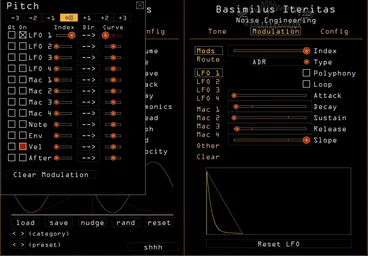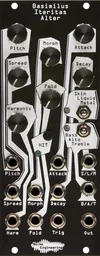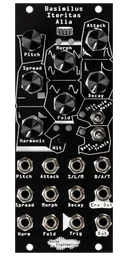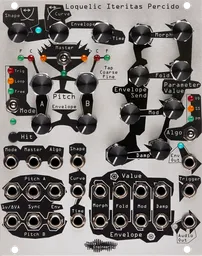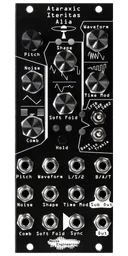Welcome back to Getting Started, the series where we explore the fundamental types of Eurorack modules and discuss what they do, how to use them, and how they fit into a system. And of course, it wouldn’t be a Noise Engineering blog without some wackiness, so at the end of each post we’ll discuss a more advanced/abstract/unusual technique for each type of module for you more experienced patchers out there.
Today, we’ll be discussing an interesting and sometimes confusing topic: what’s the difference between an oscillator module and a voice module?
What is a voice?
We should start by defining our terms here: what is a synth voice? It’s a term that applies to synthesis in general, not just modular, so you’ve probably heard it before. You can think of a voice as all the stuff it takes to make the sound for a single note. That means the sound starts and stops (with a keypress or trigger from a sequencer, for instance), and other things like dynamic information (attack, decay, etc.), pitch, and timbre are probably built into it, too. When you think of a fixed-architecture monophonic synth, the sound you get out of it is its voice. A polyphonic synth has multiple voices.
Constant back and forth: oscillators always oscillate
If you read our first post about oscillators in this series, you’ll know that oscillators always oscillate. We can control pitch, and in some cases, we’ll have some control over timbre, but if we want to control dynamics, we have to add some extra bits. We talked about that last time, so you can check that out for more info, but in essence, to make a full voice out of an oscillator, you will typically need a VCA, an envelope generator, and a gate source, at a minimum.
Voices: the whole enchilada
A complete voice module generally encompasses almost all the things you need to make your sound: there’ll be an oscillator, an envelope generator, and a VCA, and you’ll often find timbral controls in them too such as filters or wavefolders.
Not only do voice modules have a few utilities built-in, they’ll generally be prepatched, too. That means you just have to patch in a trigger or gate and maybe some pitch CV and you’re off.
What are some examples of voices?
Good question! Let’s start with a couple of voice modules made by yours truly.
Basimilus Iteritas Alter, often referred to as the BIA, was designed to be a universal drum synthesizer, but it can do a whole lot more than your basic percussion.
It can be used in a few configurations: the most basic patch would be to patch in a trigger and dial in a sound to your liking. You can have a kick, a clap, a zap, a hat, or any number of other sounds.
Add in some pitch CV and you have a synth voice that can be controlled and played like a melodic instrument. And if you add in some modulation CV and you can get a whole performance!
Voices like this are great because they’re plug-and-play: patch in a keyboard or a sequencer and you’re good to go.
Cursus Iteritas Percido is a more in-depth voice designed for melodic duties and performance. Along with the envelope, VCA, and oscillator you’d expect to find in a voice, it has a modulation matrix and macro knob that lets you completely change how the voice reacts to your playing. Similar to the BIA, it can be used with just a trigger signal, but it was designed for playing melodies with pitch CV and being modulated by, well, everything. It gives you controls that allow you to create your sound spectrally and then modify them with oversampling and a wavefolder. Plus, you can modulate each parameter with an envelope using the modulation matrix!
It’s also important to note that the CIP has a mode to behave just like a normal oscillator, too: if you want to use it in a bigger patch, that can be useful.
Wait. Why would I ever buy an oscillator if voices exist?
Great question! A voice is an extremely convenient solution if you don’t have a lot of space, if you’re on a budget, or (most importantly) you like the sound. But oscillators are handy too! If your system reaches a certain size, you’re almost certain to have the required modules to make a voice in your system. And an oscillator allows you to shape every component of the sound as you want it: if you’re patching a subtractive voice you choose the envelope, the filter, the VCA, and any other timbral components. And while you can certainly do this to some extent with a full voice module, an oscillator gives a bit more flexibility.
Now oscillators sound like the way to go. What are the drawbacks?
Now that we’ve seen how simple it is to patch with a voice module, let’s take a look at a voice patch I use a lot in my system. It contains the Rossum Electro-Music Trident oscillator, STG .MIX 3-channel mixer, the Rossum Evolution lowpass filter, the XAOC Tallin VCA, and the AJH Synth Minimod Contour Generators, generating envelopes to modulate the VCA and the filter.

As you can see, to get that voice patched, we need to do quite a bit more. Now, that added complexity isn’t a bad thing: having modules separated out into their individual functions is great for flexibility. There are quite a few different ways to patch those modules together that would give completely different sounds -- they could even be used as two separate voices, if we wanted. It is a little bit less immediate than a prepatched voice module, though. That’s why, in my opinion, single-function modules have just as much of a place in a system as full-voice modules do: sometimes I want to get into the nitty-gritty technical bits of a patch, and sometimes I just want to plug a couple of cables in and have a nice sound come out.
Do I still need envelopes and VCAs if I have a voice module?
Especially in a smaller system, it may be tempting to skip out on utilities like envelope generators or VCAs if you get a complete voice module. They’re built in, right?
Well, yes, but that doesn’t mean that having more isn’t a good thing! I often use an extra envelope or two when I patch with my BIAs: there’s a lot of interesting sounds you can get with an extra layer of modulation! Also, chances are you’ll want them down the road...
For the experienced patcher: voices as sync and FM sources
While voices aren’t often thought of as building blocks for patches, they have some really interesting uses: for instance, have you ever tried using a BIA as the FM source for another oscillator?
You should! You can get some really interesting results from a patch like that: trigger the voice for some instant FM awesomeness. Patch the modulated oscillator through a LPG, trigger it and the BIA (or other voice) at the same time, and it’ll sound a whole lot more complex than a three-module patch really should.
